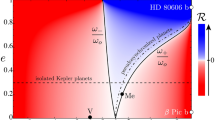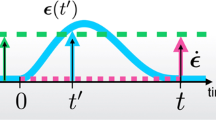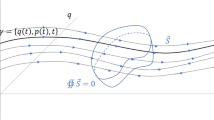Abstract
The theory that the Moon was captured by the Earth seems as probable as the theory that the two bodies were formed at the same time, according to current ideas.
This is a preview of subscription content, access via your institution
Access options
Subscribe to this journal
Receive 51 print issues and online access
$199.00 per year
only $3.90 per issue
Buy this article
- Purchase on Springer Link
- Instant access to full article PDF
Prices may be subject to local taxes which are calculated during checkout
Similar content being viewed by others
References
Colombo, G., in Measure of the Moon (edit. by Kopal, Z., and Goudas, C. L.), 12 (D. Reidel Publ. Co., Dordrecht, Holland, 1967).
Chandrasekhar, S., Principles of Stellar Dynamics, 205 (Dover, New York, 1960).
Kurt, R., Introduction to the Dynamics of Stellar Systems, 37 (Pergamon Press, London, 1957).
Pars, L. A., A Treatise on Analytical Dynamics, 435 (John Wiley and Sons, New York, 1965).
Darwin, G. H., Phil. Trans. Roy. Soc., 171, 713 (1880).
Hill, G., Amer. J. Math., 1, 129 (1878).
Kopal, Z., and Lyttleton, R. A., Icarus, 1, 455 (1963).
Nechvile, V., CR Acad. Sci., 182, 310 (1926).
Contopoulos, G., Astron. J., 72, 669 (1967).
Poincaré, H., Les Méthodes Nouvelles …, 1, 184 (Dover, 1957).
Contopoulos, G. Astron. J., 68, 1 (1963).
Arnold, V. I., Ups. Mat. Nauk, 18, 13 (1963).
Arnold, V. I., Ups. Mat. Nauk, 18, 91 (1963).
Kolmogoroff, A. N., Dokl. Akad. Nauk SSSR, 98, 527 (1954).
Kolmogoroff, A. N., Proc. Intern. Congress of Math., 1, 315 (North Holland Publ. Co., Amsterdam, 1954).
Jefferys, W. H., and Moser, J., Astron. J., 71, 568 (1966).
Goudas, C. L., Icarus, 2, 1 (1963).
Jefferys, W. H., Astron. J., 70, 393 (1915).
Darwin, G. H., Phil. Trans. Roy. Soc., 170, 713 (1879).
Darwin, G. H., Phil. Trans. Roy. Soc., 171, 713 (1880).
Gerstenkorn, H., Zeit. f. Astrophys., 36, 245 (1955).
MacDonald, G. J. F., Rev. Geophys., 2, 467 (1964).
MacDonald, G. J. F., Plan. Space Sci., 2, 249 (1960).
Wells, J. W., Nature, 197, 948 (1963).
Holmes, A., Trans. Edinburgh Geol. Soc., 17, 183 (1959).
Jeffreys, H., Mon. Not. Roy. Astro. Soc., 91, 169 (1930).
Author information
Authors and Affiliations
Rights and permissions
About this article
Cite this article
GOUDAS, C. New Integrals of Motion and the Orbital History of the Moon. Nature 218, 726–728 (1968). https://doi.org/10.1038/218726a0
Issue Date:
DOI: https://doi.org/10.1038/218726a0
This article is cited by
Comments
By submitting a comment you agree to abide by our Terms and Community Guidelines. If you find something abusive or that does not comply with our terms or guidelines please flag it as inappropriate.



